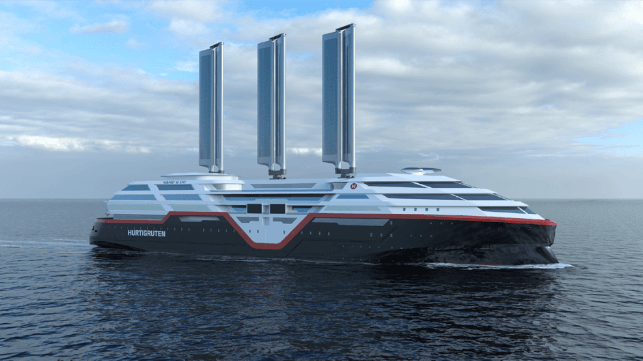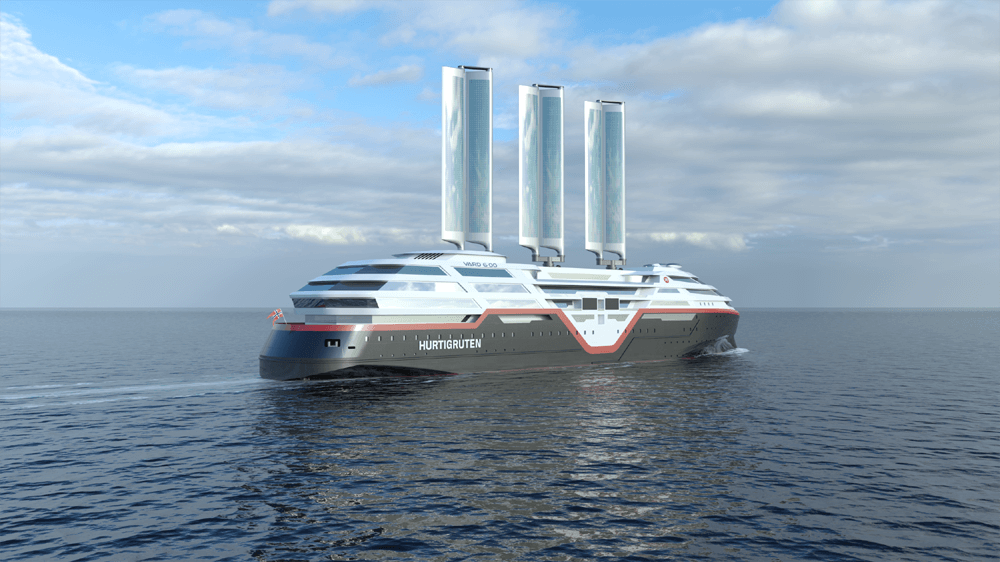Hurtigruten and Vard Reveal Updated Plans for Zero-Emission Cruise Ship

After extensive planning and testing, Norwegian cruise company Hurtigruten and shipbuilder Vard provided a preview of the second-generation design for their planned zero-emission cruise ship. Continuing to target 2030 for the introduction of the ship known as the SeaZero project, they expect the vessel will achieve an overall 40 to 50 percent energy reduction with the capability to sail entirely emission-free during normal operation.
Concepts for the cruise ship were first presented in June 2023, with the companies reporting designs have progressed. While they caution that there will be adjustments both to the design and specifications along the way, the design is being modeled on a 443-foot (135-meter) length Vard reported in June 2024. The passenger facilities would have 270 cabins with a capacity for 500 passengers and 99 crew and as with Hurtigruten’s vessels operating on the Norwegian coastal route the SeaZero concept incorporates significant cargo space and the ability to transport cards.
One key element of the ship is sails which can be raised and lowered. The companies report they have adapted the concept incorporating OceanWings, similar to those already deployed on the Ro-Ro cargo ship Canopee. The estimate indicates that the sails could reduce energy consumption by around 10 percent over time. The plan envisions incorporating solar panels on the sails to contribute a further two to three percent in energy savings.
Vard reported in June that the design envisioned the three retractable, autonomous wing rigs that would comprise 1500 square meters (16,146 square feet) of solar panels and a total wind surface of 750 square meters (8,073 sq. ft.), reaching a maximum height of 50 meters (164 feet) when fully extended.
“We still see significant energy savings from having retractable sails with solar panels, but this requires thorough studies, including model tests to be conducted in the coming months. We have also changed the sail type to a more mature design already in use on cargo ships,” said Chief Operating Officer Gerry Larsson-Fedde of Hurtigruten.

The ship is planned with contra-rotating propellers as the main propulsion and batteries which will have a capacity of around 60 megawatt-hours. Two retractable thrusters at the stern would ensure optimal maneuvering during port operations which Vard says will be supported with artificial intelligence maneuvering. The ship will have shore power capabilities and can charge its batteries from shore power.
Another measure is air lubrication of the hull to reduce drag. Hurtigruten says air lubrication can provide energy savings of 5 to 10 percent. Combined with modern hull design, advanced anti-fouling coatings, and regular hull cleaning, they state that water resistance can be significantly reduced.
Preliminary results from the design studies also show that better ventilation and insulation systems, as well as advanced energy management, can lead to significant energy savings. The concept calls for “smart cabins” which will allow guests to control energy usage through a screen in the cabin, while also seeing how much energy is being used. Hurtigruten says it is already testing advanced sensors and in the near future will conduct full-scale tests on its current ships.
Typically, they note hotel operations on a cruise ship can consume up to 50 percent of the total energy use. The goal is a 50 percent energy reduction compared to Hurtigruten’s current ships reports Vard.

The SeaZero concept won Best Concept Ship Design at the prestigious Electric & Hybrid Marine Awards in Amsterdam, the Netherlands in June 2024. The jury of over 20 people consisting of journalists, consultants, and experts in maritime technology stated that it was impressed with the SeaZero cruise ship concept.

that matters most
Get the latest maritime news delivered to your inbox daily.
Vard reported in June 2024 that Sea Zero had now entered a two-year phase in which the proposed technologies will be tried, tested, and developed further in pursuit of the final zero-emission ship. The current research and development phase focuses on battery production, propulsion technology, hull design, and sustainable practices that reduce energy use to an absolute minimum.
Hurtigruten began installing batteries aboard its existing cruise and expedition vessels starting with the Roald Amundsen in 2019 and reports its Expeditions division now has three battery-hybrid ships out of its seven-ship fleet. The company continues to upgrade its existing fleet with various technologies that will cut CO2 emissions and improve efficiency.
